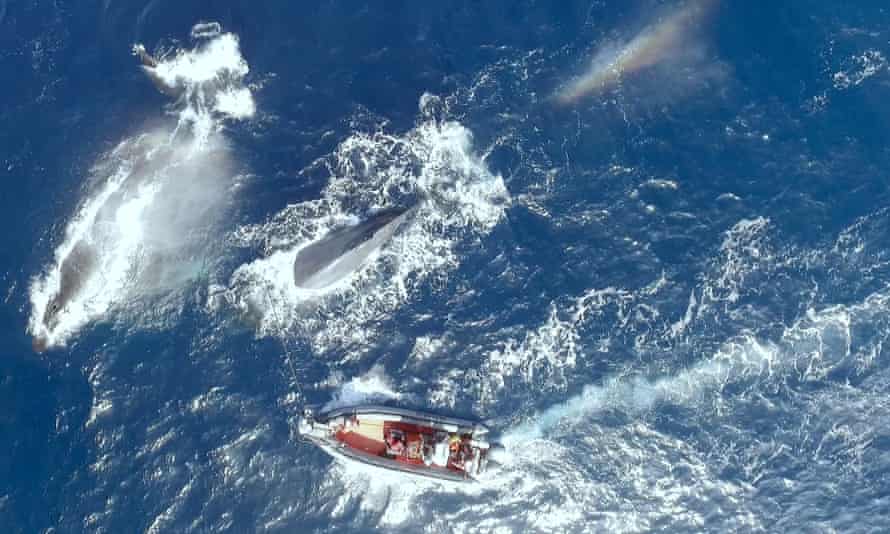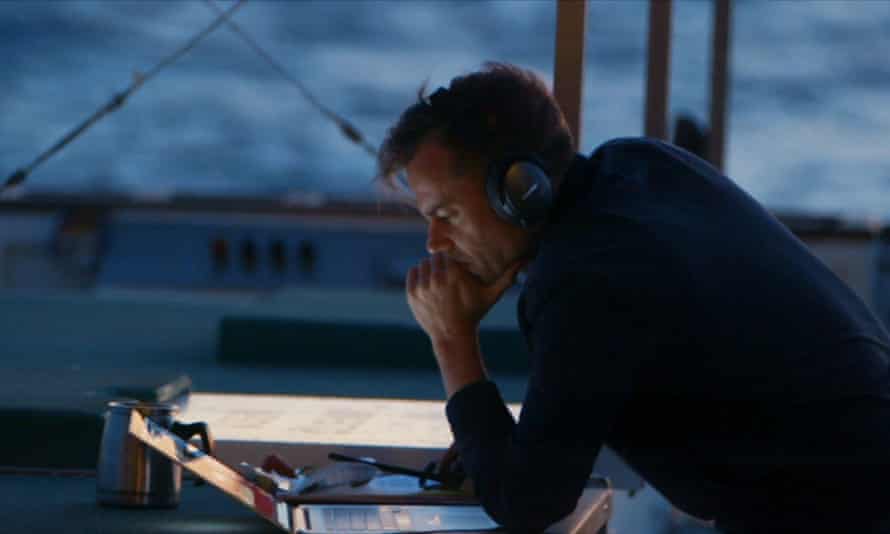The search for the loneliest whale in the world

When people learned he vocalized at a much higher pitch than other whales, they wondered: could other whales hear him? Was he plaintively calling, never hearing a reply? Was he lonely?
The loneliest whale in the world lives in the north Pacific. Scientists have been tracking him on and off for more than 30 years – listening to his vocalizations as he swims back and forth across his patch of ocean, calling into the void and waiting for a reply that never comes. That’s the story, anyway. The makers of a new documentary set out to find the truth – and the whale – but what they discovered is that a whale struggling to be heard may not be that unusual at all.
The tale has its origins in the cold war, when the US military deployed a network of hydrophones across the ocean floor to listen for Soviet submarines. In the process, operators also picked up unexpected background noises, including a series of strange, low-frequency moans initially attributed to an unknown “Jezebel Monster” but later identified as the deep, rumbling calls of blue and fin whales. By the end of the 1980s, with the cold war spluttering to an end, the Pentagon made the network available to whale researchers. Among them was William Watkins, a pioneer in identifying and tracking marine mammals by the sounds they make.
Soon after he was granted access to the hydrophone network, he noticed one call that stood out from the rest: it bore the signature of blue and fin whale calls, but whereas fins vocalize primarily in the 15 to 30Hz range, this whale was vocalizing at 52Hz – still at the lowest limits of human hearing – but for the largest whales, it was the equivalent of speaking like Mickey Mouse.
Watkins and his team tracked the whale for more than a decade. They published a paper about the potential of underwater sound systems such as the Pentagon’s for tracking individual whales in 2004, but when the paper received mainstream media coverage, the whale entered the popular imagination. People began to wonder: if the whale was vocalizing on a different frequency to others, could other whales hear him? Could he hear them? Was he swimming the ocean, plaintively calling into the darkness? Was he alone? Was he … lonely?
The whale prompted poems and plays, sculptures and, inevitably, a parody Twitter account. (“Hellooooooo?! Yoooohoooooo! Is anyone out there? #SadLife.”)
The whale seemed to speak to people who were experiencing loneliness and doubt. Wracked with loneliness and trapped in a day job he hated, a musician composed an album inspired by the whale. A film-maker I spoke to who was suffering daily angst at the unraveling of one of his movies calmed himself by picturing a whale alone in the ocean and listening to recordings of his calls (the whale is almost certainly male). In 2015 the massively popular K-Pop band BTS released Whalien 52, a song about a whale with a “low, calm, and lonely voice” that “can never reach someone else, no matter how hard it shouts”.

The more prosaic truth is that there is no scientific reason to believe the whale is lonely at all, let alone lonelier than any other whale in the ocean. Christopher Clark of Cornell University, one of the world’s foremost experts on whale communications, told the BBC in 2015: “Blue whales, fin whales and humpback whales: all these whales can hear this guy; they’re not deaf. He’s just odd.” Ana Sirovic, associate professor at Texas A&M University at Galveston, adds: “The question is what do these other whales perceive it as? What does it mean to them? Is it strange and something they completely ignore? Or is it something that they understand to be just slightly off from their own signals?”
Yet the fascination endures. When Joshua Zeman, documentary film-maker and producer of such series as The Killing Season and Sons of Sam, heard about the whale, he began developing a movie that examined those obsessed with the whale as much as the whale himself. Then he changed tack: he would raise money, find a boat and convince a team of scientists to help him find the loneliest whale in the world.
From the outset, the quest seemed profoundly quixotic. In the documentary, entitled The Loneliest Whale: The Search for 52 – available on digital platforms in the US from July 16 – one oceanographer described it as harder than finding a needle in a haystack.
Worse yet, scientists assumed the whale was dead, telling Zeman they had not heard him in years – a hugely inconvenient development given that Zeman had raised $400,000 on Kickstarter to fund an expedition. Then, the unexpected happened again: an intern poring through recordings found the whale alive and presumably well – but in a surprising spot. While early researchers like Watkins had tracked the whale primarily in the tempestuous Gulf of Alaska and in the eastern north Pacific, it was now likely closer to shore off the west coast of the United States – seemingly within reach of Los Angeles.

But if the 52Hz whale’s relative proximity to the California coast offered increased accessibility, it also introduced a new challenge: the coast is home to some of the world’s busiest shipping lanes. At one point in the documentary, just as the team hopes it is closing in on their quarry, the scientists’ laptop screens turn red as their hydrophones are overwhelmed by the sound from a passing cargo vessel.
“I didn’t expect that we would wind up having a villain,” says Zeman. “I get all the way out there and you’re telling me that part of the reason we can’t hear [the whale] is because of this thing?”
Numerous studies have proven that commercial shipping noise interferes with the ability of large whale species to communicate. In Cape Cod Bay, noise pollution created primarily by shipping traffic has shrunk the acoustic space of right whales – the distance over which their vocalizations can be heard – by two-thirds. Other whales have been forced to increase the volume and frequency of their calls to be heard above the cacophony. Another study found that, as commercial shipping declined precipitously in the immediate aftermath of the attacks of 11 September 2001, so did levels of stress hormones detected in right whale feces.
As the documentary approaches its climax, shipping noise appears to have foiled the searchers’ attempts to find the 52Hz whale. But then the scientists make a shocking discovery, which inspires as many questions as answers – even as it appears definitively to dismiss the romantic notion of the whale’s loneliness.

If you’d like to know more about that discovery, you’ll have to watch the documentary. Regardless, there is a clear takeaway. The deafening sound of a lone container vessel – just one of thousands crisscrossing the ocean – leads us to an ironic realization: while we were troubled about the loneliest whale in the world, tens of thousands of cargo ships have been creating an ocean full of lonely whales, their calls drowned out by the sounds of everyday commerce, rumbling ever louder in a desperate attempt to be heard.